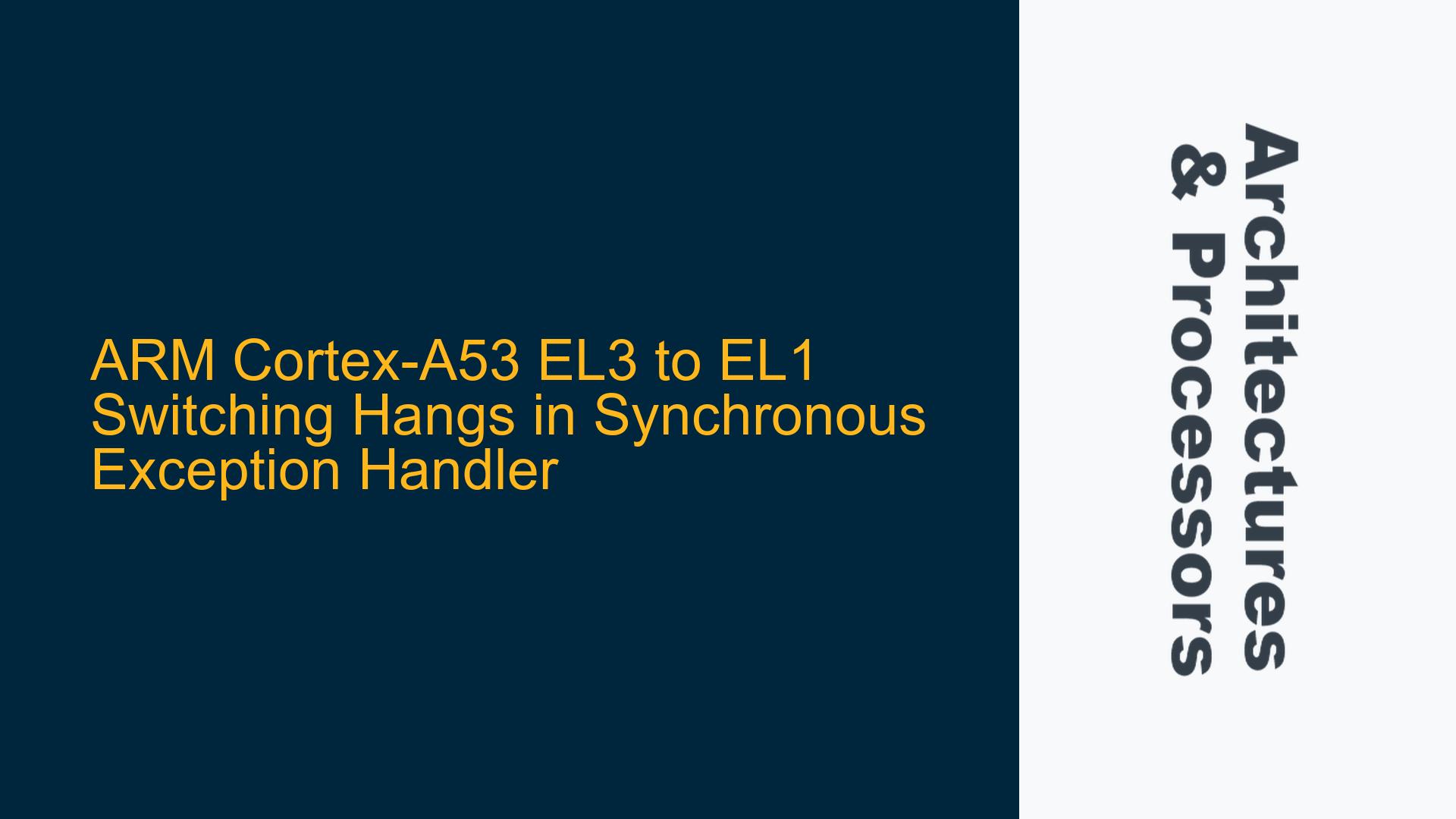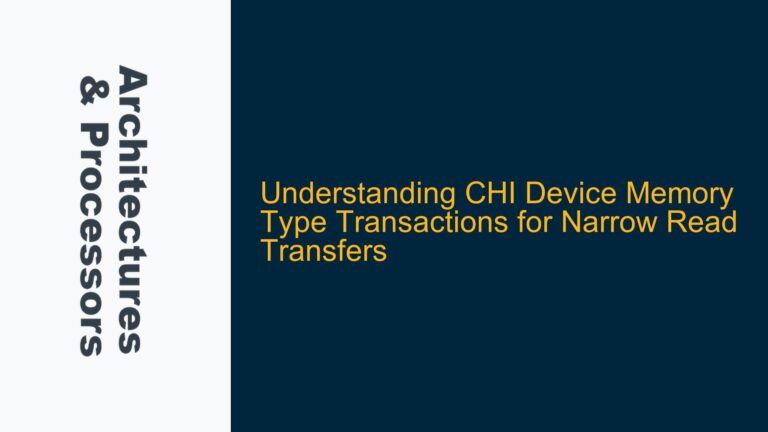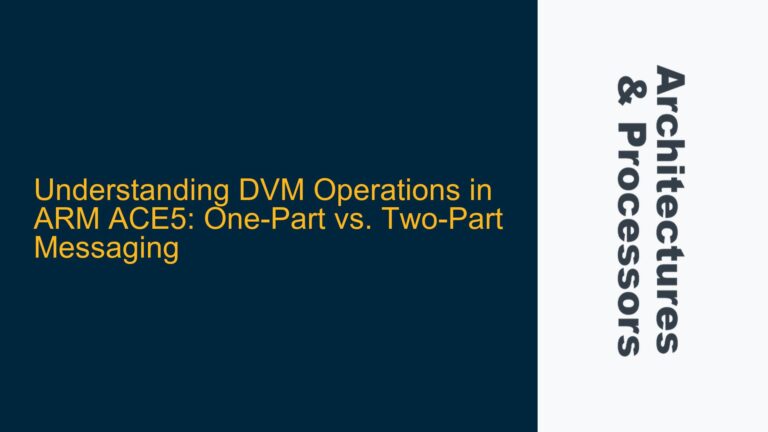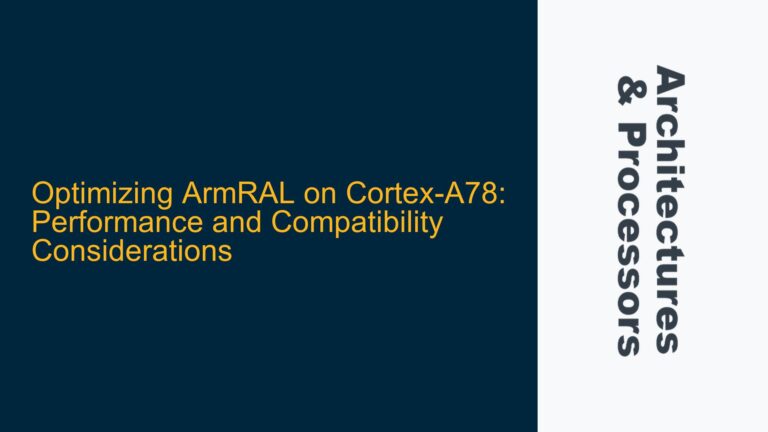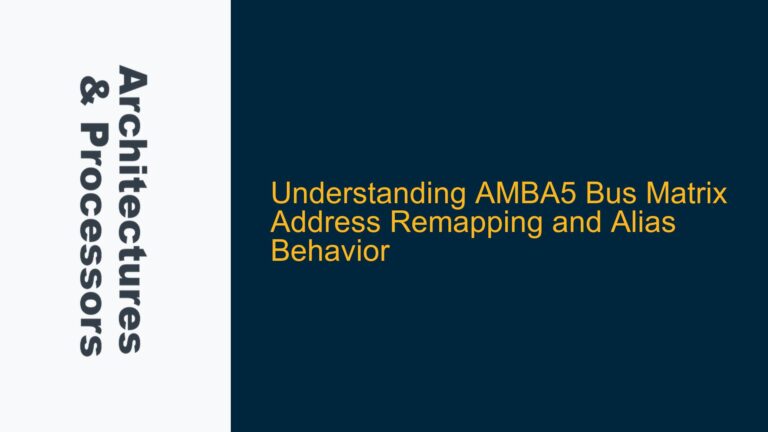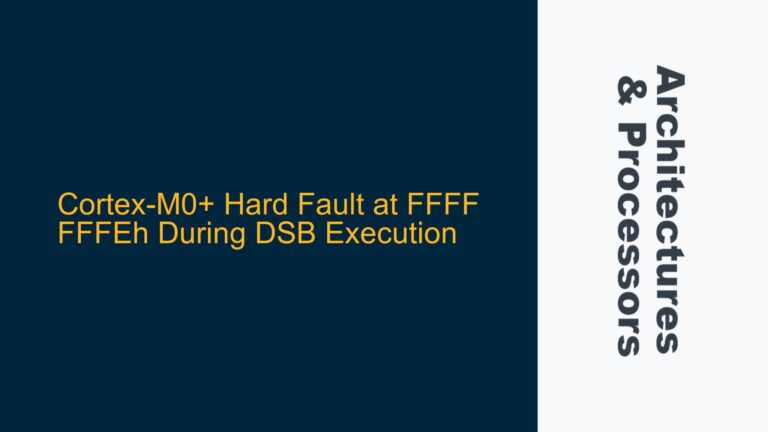ARM Cortex-A53 Exception Level Transition Issues During BSP Development
When developing a Board Support Package (BSP) for the NXP i.MX8M Mini, which utilizes the ARM Cortex-A53 processor, transitioning from Exception Level 3 (EL3) to Exception Level 1 (EL1) can be a complex task. The Cortex-A53 processor, being part of the ARMv8-A architecture, supports multiple exception levels, each with its own set of registers and execution states. The transition from EL3 to EL1 involves configuring several system registers, including the Saved Program Status Register (SPSR_EL3) and the Exception Link Register (ELR_EL3). A common issue encountered during this transition is the processor hanging in the synchronous exception handler (cxsynx), which is often indicative of a misconfiguration in the exception handling mechanism or the stack pointer setup.
The primary symptom of this issue is the processor entering an infinite loop within the synchronous exception handler, which is triggered when the processor attempts to execute an instruction that results in an exception. This can occur due to a variety of reasons, such as an incorrect stack pointer configuration, improper exception level transition, or misaligned memory access. The synchronous exception handler is designed to handle such exceptions, but if the handler itself is not properly configured, the processor may fail to recover, leading to a hang.
In the context of the NXP i.MX8M Mini, the transition from EL3 to EL1 is typically performed during the initialization phase of the BSP. The processor starts execution in EL3, which is the highest privilege level, and then transitions to lower exception levels as part of the boot process. The transition to EL1 is necessary to execute the operating system or application code, which typically runs at EL1. However, if the transition is not performed correctly, the processor may fail to execute the intended code, resulting in a hang.
Misconfigured SPSR_EL3 and EL1 Stack Pointer Setup
One of the most common causes of the processor hanging during the transition from EL3 to EL1 is a misconfigured SPSR_EL3 register. The SPSR_EL3 register is used to save the processor state when an exception is taken to EL3. When transitioning from EL3 to EL1, the SPSR_EL3 register must be configured to reflect the desired state of the processor at EL1. This includes setting the appropriate exception level, execution state (AArch64 or AArch32), and other processor state bits.
If the SPSR_EL3 register is not configured correctly, the processor may attempt to execute code at EL1 with an incorrect state, leading to a synchronous exception. For example, if the execution state is set to AArch32 when the code at EL1 is written for AArch64, the processor will generate an exception when it attempts to execute the AArch64 code. Similarly, if the stack pointer for EL1 is not properly configured, the processor may attempt to access an invalid memory location, resulting in a synchronous exception.
Another potential cause of the issue is the improper setup of the EL1 stack pointer. The stack pointer for EL1 must be initialized before transitioning to EL1, as the processor will use this stack pointer to store temporary data and return addresses during exception handling. If the stack pointer is not properly initialized, the processor may attempt to access an invalid memory location, leading to a synchronous exception. Additionally, if the stack pointer is not aligned to the required boundary (16 bytes for AArch64), the processor may generate an alignment fault, which will also result in a synchronous exception.
In the case of the NXP i.MX8M Mini, the stack pointer for EL1 is typically initialized in the BSP code before transitioning to EL1. However, if the stack pointer is not properly aligned or points to an invalid memory region, the processor may hang in the synchronous exception handler. This can be particularly challenging to debug, as the issue may not be immediately apparent from the code.
Correcting SPSR_EL3 Configuration and Aligning EL1 Stack Pointer
To resolve the issue of the processor hanging in the synchronous exception handler during the transition from EL3 to EL1, it is essential to ensure that the SPSR_EL3 register is correctly configured and that the EL1 stack pointer is properly aligned and initialized. The following steps outline the necessary actions to correct these issues:
-
Configure SPSR_EL3 Correctly: The SPSR_EL3 register must be configured to reflect the desired state of the processor at EL1. This includes setting the appropriate exception level (EL1), execution state (AArch64 or AArch32), and other processor state bits. The following code snippet demonstrates how to configure the SPSR_EL3 register for a transition to EL1 in AArch64 mode:
MOV X0, #0x3C5 // Set EL1h mode with interrupts disabled MSR SPSR_EL3, X0In this example, the value
0x3C5is written to the SPSR_EL3 register, which sets the processor to EL1h mode (EL1 with SP_EL1 as the stack pointer) and disables interrupts. The exact value written to SPSR_EL3 will depend on the desired processor state at EL1. -
Initialize EL1 Stack Pointer: The stack pointer for EL1 must be initialized before transitioning to EL1. The stack pointer should point to a valid memory region and be aligned to the required boundary (16 bytes for AArch64). The following code snippet demonstrates how to initialize the stack pointer for EL1:
LDR X0, =el1_stack_top // Load the top of the EL1 stack MSR SP_EL1, X0 // Set SP_EL1 to the top of the EL1 stackIn this example, the top of the EL1 stack is loaded into register X0 and then written to the SP_EL1 register. The
el1_stack_topsymbol should be defined in the linker script to point to the top of the memory region reserved for the EL1 stack. -
Perform Exception Return: Once the SPSR_EL3 and SP_EL1 registers are configured, the processor can transition to EL1 by performing an exception return. The following code snippet demonstrates how to perform an exception return to EL1:
LDR X0, =el1_entry // Load the entry point for EL1 MSR ELR_EL3, X0 // Set ELR_EL3 to the EL1 entry point ERET // Perform exception return to EL1In this example, the entry point for EL1 is loaded into register X0 and then written to the ELR_EL3 register. The
el1_entrysymbol should be defined to point to the first instruction to be executed at EL1. TheERETinstruction is then used to perform the exception return, which causes the processor to transition to EL1 and begin executing code at the specified entry point. -
Verify Memory Alignment: Ensure that the stack pointer and any other memory regions accessed by the processor are properly aligned. Misaligned memory access can result in alignment faults, which will cause the processor to generate a synchronous exception. The following code snippet demonstrates how to verify the alignment of the stack pointer:
LDR X0, =el1_stack_top // Load the top of the EL1 stack AND X0, X0, #0xF // Check alignment to 16 bytes CBNZ X0, alignment_fault // Branch to fault handler if misalignedIn this example, the top of the EL1 stack is loaded into register X0, and the lower 4 bits are checked to ensure that the stack pointer is aligned to a 16-byte boundary. If the stack pointer is misaligned, the processor branches to a fault handler to handle the alignment fault.
-
Debugging Synchronous Exceptions: If the processor continues to hang in the synchronous exception handler, it may be necessary to debug the exception handler itself. This can be done by examining the exception syndrome register (ESR_EL3) to determine the cause of the exception. The following code snippet demonstrates how to read the ESR_EL3 register:
MRS X0, ESR_EL3 // Read the exception syndrome registerThe value in the ESR_EL3 register can be used to determine the cause of the synchronous exception, such as an instruction abort, data abort, or alignment fault. This information can be used to further diagnose and resolve the issue.
By following these steps, the issue of the processor hanging in the synchronous exception handler during the transition from EL3 to EL1 can be resolved. It is essential to ensure that the SPSR_EL3 register is correctly configured, the EL1 stack pointer is properly aligned and initialized, and that any memory accesses are aligned to the required boundary. Additionally, debugging the synchronous exception handler can provide valuable insights into the cause of the exception and help to further diagnose and resolve the issue.
